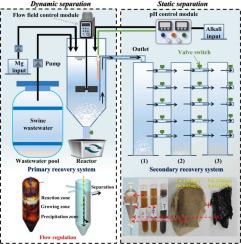Minimization of heavy metal adsorption in struvite through effective separation and manipulation of flow field
Abstract
The admixture of heavy metals on struvite during the P recovery process from wastewater will affect its value for safe agricultural application, but it is not clear how to effectively separate heavy metals from struvite. Herein, a two-stage separation reactor (static and dynamic) has been developed to achieve efficient separation of heavy metals and struvite. The generation of struvite from real swine wastewater would naturally precipitate to the lowest layer under static conditions, leading to an enrichment of heavy metals (75 % Cu and 84 % Zn) in suspension. Meanwhile, phosphorus recovery from real swine wastewater results in the generation of a large amount of fines flowing out of the reactor due to the effects of suspended solids (SS), etc., making it necessary to recover phosphorus by static separation. For the dynamic separation step, we also analyzed the characteristics of struvite formation at different rotational speeds in a continuous reaction system. The results demonstrated that the shear rate of the fluid affects the particle size of struvite, which in turn determines the rate and the distribution of struvite in either primary or secondary recovery tanks. The implementation of zonal regulation in the flow field can produce a higher phosphorus efficiency (from 85.8 to 95.5 % at pH=8.1–8.2, from 93.8 to 98.5 % at pH=9.0–9.1) and a lower alkali consumption (55.56 % of alkali cost), which is favorable for the separation of struvite crystals and heavy metals (the amount of Cu and Zn metals separated increased by more than 50 %), and ultimately yield high quality of struvite. The findings in this study will provide insights for the separation and reduction of heavy metals through a combined method with dynamic and static in a continuous system, providing a reference for the safe application of struvite in agriculture.


 求助内容:
求助内容: 应助结果提醒方式:
应助结果提醒方式:


